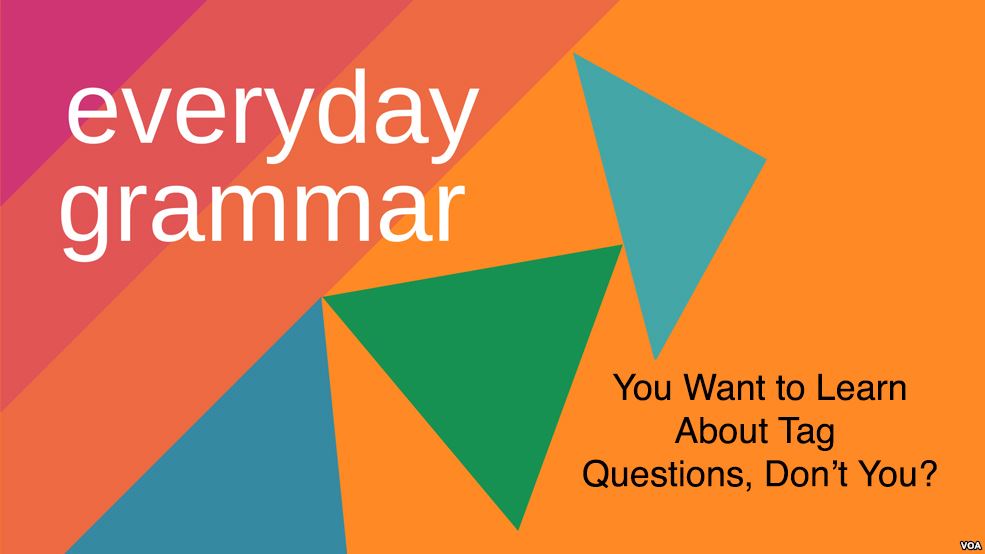Have you ever been in a conversation and wanted to check your understanding? That is the time to use a tag question in English.
A tag question is a short question added to a statement. The tag includes a pronoun and its matching form of the verb be, or auxiliary verb. If the tag question is negative, we shorten the phrase, or use a contraction with the auxiliary verb. Here’s an example:
I was visiting a friend and saw a photo on the wall. I said,
“That’s a picture of your grandson, isn’t it?”
My friend answered,
“Yes, it is. That picture is from when he was two. He’s a lot taller now.”
Purpose of tag questions
In the example, I wanted to confirm something I thought was true. So I started with a positive statement, “That’s a picture of your grandson” then I added a negative tag question: “isn’t it?” My friend said I was right – the picture was of his grandson.
English speakers use tag questions to encourage a listener to respond. You will often hear teachers using tag questions:
“You remember the history lesson from last week, don’t you?”
Some language researchers say that men use tag questions more often than women. They think it might show that men have more power in the conversation, and use tags to ask for information or agreement. Others say women use a certain kind of tag questions to make the conversation run more smoothly.
Whatever your gender, when you use a tag question you expect an answer. The form of that answer depends on the type of tag question. Let’s look at the two types of tag questions.
Positive statements with negative tags
We’ll talk first about tag questions that follow a positive statement with the verb be. They use a reduced form, or contraction. Make the tag question with a form of the verb be combined with the negative not and the pronoun. The verb be has to match the number and person of the pronoun. Take a look at these examples:
They are walking to school, aren’t they?
She is taking the bus, isn’t she?
I am supposed to be sitting here,
aren’t I?
You’re
the math teacher, aren’t you?
In these examples, you reverse the order of the pronoun and verb in the tag question. “They are” becomes “aren’t they?” and “She is” becomes “isn’t she?”
If the statement uses another verb instead of be, the tag question uses an auxiliary verb such as do or have. For example, in the song A Little Time the singing duo Beautiful South ask the question,
You need a little room for your big head,
Don’t you, don’t you?
and
Your face has been looking like that for hours
Hasn’t it, hasn’t it?
If you ask a negative tag question you expect a positive answer.
Question: It’s raining out, isn’t it?
Expected answer: Yes, it is.
Negative statements with positive tags
Now let’s look at tag questions that follow a negative statement. These are in the affirmative. You can use this to confirm that what you are thinking is true, and you expect a negative answer.
Question: You don’t eat all the cake, do you?
Expected answer: No, I don’t.
Negative sentences with positive tag questions are not as frequent as our first type. They use the same form, with reversed word order.
British or American?
Tag questions are an example of a big difference between British and American English. Language researchers using computer data found that British English speakers used tag questions nine times as often as American English speakers!
Changing question intonation
In Understanding and Using English Grammar, Betty Azar says that the intonation (change in pitch) shows the purpose of a tag question. If the speaker is trying to confirm information, the tone rises:
Adam works at VOA, doesn’t he?
Speakers saying something that they are almost certain the listener will agree with use a falling intonation.
It’s a nice day, isn’t it?
We leave you with a famous line from Carly Simon, in the song You’re So Vain:
You’re so vain, you probably think this song is about you
You’re so vain, I’ll bet you think this song is about you
Don’t you? don’t you?
For VOA Learning English, I’m Jill Robbins.
And I’m Jim Tedder.
Dr. Jill Robbins wrote this story for Learning English. Hai Do was the editor.
______________________________________________________________
Words in This Story
confirm – v. to state or show that (something) is true or correct
reverse – v. to change the order or position of (two things or a series)
intonation – n. the rise and fall in the sound of your voice when you speak
pitch – n. the highness or lowness of a sound
Now it’s your turn. Write a sentence with a tag question in the comments. We’ll give you feedback.

